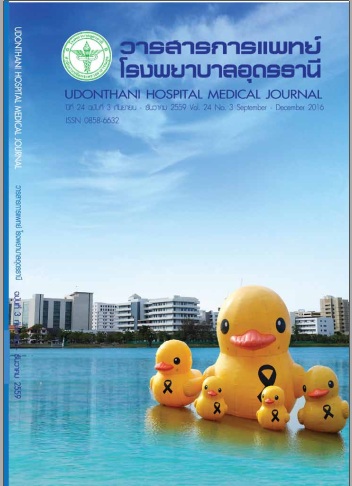คุณสมบัติของ Fosfomycin Polymethylmethacrylate Beads ในการยับยั้งการเจริญเติบโตของแบคทีเรียภายหลังกระบวนการทำไร้เชื้อ
คำสำคัญ:
การทดสอบความไวของเชื้อแบคทีเรีย, เม็ดบีดสีผสมยาปฎิชีวนะบทคัดย่อ
วัตถุประสงค์: Fosfomycin ที่ผสมกับ polymethylmethacrylate beads (FPMMA) สามารถใช้รักษาภาวะติดเชื้อของกระดูก การผสมแล้วใช้แต่ละครั้ง มักมี FPMMA เหลือ หากสามารถเก็บในภาวะไร้เชื้อเพื่อนำมาใช้ในภายหลัง ก็จะช่วยประหยัดเวลาและค่าใช้จ่ายได้ จึงเป็นแนวคิดในการทำการศึกษาเปรียบเทียบคุณสมบัติของ FPMMA ก่อนและหลังผ่านกระบวนการทำไร้เชื้อด้วยวิธีการอบแก๊ส (Ethylene Oxide sterilization) ในการยับยั้งการเจริญเติบโตของเชื้อแบคทีเรีย Methicillin-sensitive Staphylococcus aureus (MSSA), Methicillin-resistant Staphylococcus aureus (MRSA), E. coli, Enterococcus sp. และ Pseudomonas aeruginosaโดยรูปแบบการวิจัยเป็นการวิจัยเชิงทดลอง
วิธีดำเนินการวิจัย: ผสม Fosfomycin กับ PMMA แล้วปั้นเป็นเม็ดรอจนแข็งเต็มที่จำนวน 20 เม็ด แบ่งออกเป็นสองกลุ่ม คือกลุ่มควบคุมจำนวน 10 เม็ด และกลุ่มทดลองจำนวน 10 เม็ด โดยนำกลุ่มทดลองไปผ่านกระบวนการทำไร้เชื้อด้วยวิธีอบแก๊ส ethylene oxide ก่อน จากนั้นจึงนำทั้งสองกลุ่มเข้าสู่ขั้นตอนการทดสอบความไวกับเชื้อแบคทีเรีย MSSA, MRSA, E. coli, Enterococcus sp. และ Pseudomonas aeruginosa ในหลอดทดลองด้วยวิธี Modifed Broth dilution วัดความขุ่นของอาหารเลี้ยงเชื้อในหลอดทดลอง หน่วยเป็น Mcfarland ที่ 24 ชม. หลังการเพาะเชื้อและใช้ independent t-test ในการวิเคราะห์เปรียบเทียบค่าเฉลี่ยระหว่างสองกลุ่ม
ผลการวิจัย: MSSA, MRSA, E. coli, Enterococcus sp, และ และ Pseudomonas aeruginosa มีค่าเฉลี่ยความขุ่นของอาหารเลี้ยงเชื้อในกลุ่มควบคุม เท่ากับ 0.21+0.02, 0.58+0.04, 1.14+0.10, 0.32+0.03 และ 0.36+0.02 ตามลำดับ ส่วนค่าเฉลี่ยความขุ่นของอาหารเลี้ยงเชื้อในกลุ่มทดลองพบว่าเท่ากับ 0.02+0.01, 0.18+0.02, 1.20+0.12, 2.60+0.25 และ 0.22+0.02 ตามลำดับเช่นกัน ซึ่งเมื่อนำค่าเฉลี่ยของทั้งสองกลุ่มมาเปรียบเทียบกันพบว่า ค่าเฉลี่ยความขุ่นของอาหารเลี้ยงเชื้อ MSSA, MRSA และ Pseudomonas aeruginosa ลดลง แต่เชื้อ E. coli และ Enterococcus sp. เพิ่มขึ้น โดยทุกเชื้อมีความแตกต่างอย่างมีนัยสำคัญทางสถิติ (p-value < 0.05)
สรุป: การนำ FPMMA มาผ่านกระบวนการทำไร้เชื้อด้วยแก๊ส ethylene oxide พบว่าสามารถยับยั้งการเจริญเติบโตของเชื้อ MSSA, MRSA, และ Pseudomonas aeruginosa ได้ดี แต่ยับยั้งการเจริญเติบโตของเชื้อ E. Coli และ Enterococcus sp. ไม่ได้
เอกสารอ้างอิง
2. Patzakis MJ, Muzar K, Wilins J, Sherman R, Holtom P. Septopal beads and autogenous bone grafting for bone defect in patient with chronic osteomyelitis. Clin Orthop Relat Res 1993; 295: 112-8.
3. Haydon RC, Blaha JD, Mancinelli C, Koike K. Audiometric thresholds in osteomyelitis patients treated with gentamicinimpregnated polymethylmetacrylate beads (Septopal). Clin Orthop Relat Res 1993; 295: 43-6.
4. Klemm KW. Antibiotic bead chains. Clin Orthop Relat Res 1993; 295: 63-76.
5. Blaha JD, Calhoun JH, Nelson CL, Henry SL, Seligson D, Esterhai JL Jr, et al. Comparison of the clinical efcacy and tolerance of gentamicin PMMA beads on surgical wire versus combined and systemic therapy for osteomyelitis. Clin Orthop Relat Res 1993; 295: 8-12.
6. Nelson CL, Hickmon SG, Harrison BH. Elution characteristic of gentamicin-PMMA beads after implantation in humans. Orthopedics 1994; 17: 415-6.
7. Klemm K. The use of antibioticcontaining bead chains in the treatment of chronic bone infections. Clin Microbiol Infect 2001; 7: 28-31.
8. Buchholz HW, Elson RA, Engelbrecht E, Lodenkamper H, Rottger J, Siegel A. Management of deep infection of total hip replacement. J Bone Joint Surg Br 1981; 63: 342-53.
9. Torholm C, Lidgren L, Lindberg L, Kahlmeter G. Total joint arthroplasty with gentamicin-impregnated cement. A clinical study of gentamicin excretion kinetics. Clin Orthop Relat Res 1993; 181: 99-106.
10. Salvati EA, Callaghan JJ, Brause BD, Klein RF, Small RD. Reimplantation in infection. Elusion of gentamicin from cement and beads. Clin Orthop Relat Res 1986; 207: 83-93.
11. Lindberg LT. Septopal chains in operations to exchange infected total hip arthroplasties. Reconstr Surg Traumatol 1988; 20: 47-54.
12. Buchholz HW, Engelbrecht H. berdie Depotwirkung einiger Antibiotica bei Vermischungmitdem Kunstharz Palacos. Chirurg 1970; 41: 511-5.
13. Buchholz HW. Gartmann HD. Infektionsprophylaxe und operative Behandlung der scheichendentiefen Infektion bei der totalen Endoprothese. Chirurg 1972; 43: 446-53.
14. Klemm K. Indication for and technic of gentamicin-PMMA- spheres insertion in bone and soft tissue defects. Aktuelle Probl Chir Orthop 1979; 12: 121-7.
15. Anthony A. et al. Effectiveness of local antibiotic delivery with an osteoinductive and osteoconductive bone graft substitute. J Bone Joint Surg Am 2005 Jan;87(1): 107-112.
16. Traub WH. Leonhard B. Heat stability of the antimicrobial activity of 62 antimicrobial agents. J Antimicrob Chemother 1995 Jan:35(1):149-54
17. Marks KE, Nelson CL, Lautenschlager EP. Antibiotic-impregnated acrylic bone cement.J Bone Joint Surg Am. 1976 Apr;58(3):358-64.
18. Hanssen AD., Spangehl MJ. Practical application of antibiotic loaded bone cement for treatment of infected joint replacements. Clin Orthop Relat Res 2004 Oct;(427):79-85. \
19. Springer BD. et al. Systemic safety of high-dose antibiotic-loaded cement spacers after resection of an infected total knee arthroplasty. Clin Orthop Relat Res 2004 Oct;(427):47-51.
ดาวน์โหลด
เผยแพร่แล้ว
รูปแบบการอ้างอิง
ฉบับ
ประเภทบทความ
สัญญาอนุญาต
การละเมิดลิขสิทธิ์ถือเป็นความรับผิดชอบของผู้ส่งบทความโดยตรง
ผลงานที่ได้รับการตีพิมพ์ถือเป็นลิขสิทธิ์ของผู้นิพนธ์ ขอสงวนสิทธิ์มิให้นำเนื้อหา ทัศนะ หรือข้อคิดเห็นใด ๆ ของบทความในวารสารไปเผยแพร่ทางการค้าก่อนได้รับอนุญาตจากกองบรรณาธิการ อย่างเป็นลายลักษณ์อักษร



